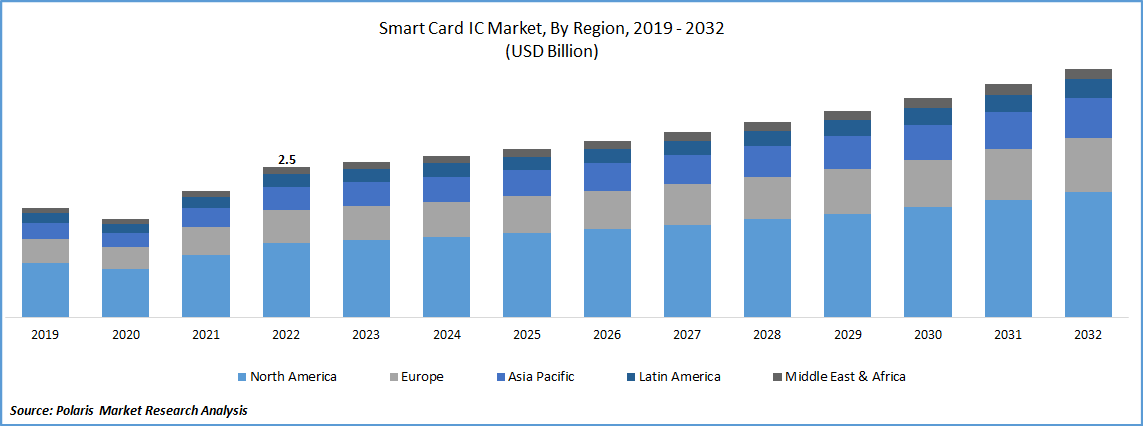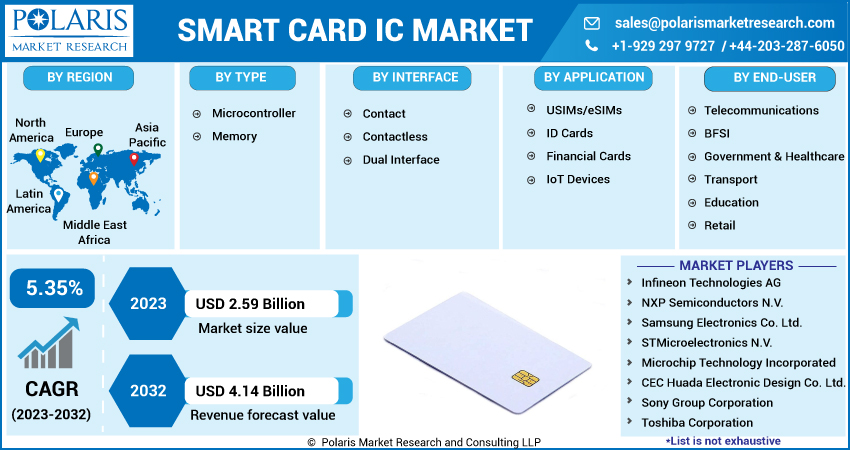
Smart Card IC Market Share, Size, Trends, Industry Analysis Report
By Type (Microcontroller and Memory); By Interface; By Application; By End-User; By Region; Segment Forecast, 2023-2032
- Published Date:Jun-2023
- Pages: 118
- Format: PDF
- Report ID: PM3323
- Base Year: 2022
- Historical Data: 2019-2021
Report Outlook
The global smart card IC market was valued at USD 2.5 billion in 2022 and is expected to grow at a CAGR of 5.35% during the forecast period. Gradual shift of organizations from the digitalization of the payment processes & efficient and secure storage of the personal data coupled with the surging adoption of the IoT & advancements in the micro-embedded electronics are among the major factors driving the global market growth. The increasing consumer inclination towards the cashless payments and adoption of devices with improved embedded circuits used in several sectors including retail, healthcare, BFSI, and hospitality along with the introduction to more improved and developed solutions by key market players, are significantly contributing towards the market growth.

To Understand More About this Research: Request a Free Sample Report
For instance, in January 2022, Samsung Electronics, introduced its new finger-print security IC named “S3B512C” with improved security features. It combines a sensor, secure element, & secure processor, that adds extra step for authentication & security in payment cards and can be also used in cards requiring highly secured authentication like student identification.
Moreover, rapid growth in the development in telemedicine and many other healthcare technologies, that allow patients to use the smart cards to receive the medical care remotely via tele-health platform. Thus, demand for the smart cards is notably rising as patients and healthcare providers are continuously seeking more secure and convenient way to access medical treatments and make payments, that is creating huge potential for the market over the coming years. The outbreak of the COVID-19 pandemic has significantly impacted the growth of the smart card IC market. The rapid emergence of deadly coronavirus across the globe resulted in temporary closure of businesses and their manufacturing units and imposed lockdown in many countries has significantly disrupted the global supply chain, thereby posing several challenges for manufacturers and companies to reach their customers.

For Specific Research Requirements, Request for Customized Report
Industry Dynamics
Growth Drivers
There has been a significant rise in the number of contactless payments across both developed and developing countries, as people are drastically shifting towards contactless payment options due to several reasons including high convenient and hygiene prospective, that has boosted the adoption of smart card ICs globally, and impacting the global market growth in a very positive way. Furthermore, with the advent of Industry 4.0, various manufacturing processes become fully automates with very little and no human interferences, as it works on Internet of Things, cyber-physical systems, cloud computing, big data, cloud robotics, that has gained attention of various technology vendors, business decision-makers, organizations, and consumers in the recent years, and is propelling the demand and growth of the smart card IC market.
Report Segmentation
The market is primarily segmented based on type, interface, application, end-user, and region.
|
By Type |
By Interface |
By Application |
By End-User |
By Region |
|
|
|
|
|
To Understand the Scope of this Report: Speak to Analyst
Microcontroller segment accounted for the largest market share & is expected to maintain its dominance during forecast period
The microcontroller segment accounted for major global market share and is likely to retain its market position throughout the forecast period. The growing popularity and uses of microcontroller in wide range of application verticals due to its several beneficial characteristics including low time required for performing operation, easy to use, high adaptability of processor chips, and less size of the systems and cost are key factors driving the demand and growth of the segment market.
The memory card segment is expected to grow at a significant growth rate during the course of study period. The growth of the segment market can be highly attributed to its high reliability, large amount of storage while being small in size, highly portable, compatibility, and many others. Additionally, memory cards require significant low amount of power to perform function without wasting power of the device, that makes them suitable for various battery-based devices.
Dual interface segment is expected to witness highest growth during forthcoming years
The dual interface segment is expected to grow at a higher CAGR over the anticipated period, which is highly attributable to its easy compatibility with both contact and contactless terminals along with the increasing focus of major market players on developing dual interface chips & pins. Additionally, dual interface smart cards are being used for wide range of applications such as physical access control, secured authentication, secure storage of sensitive information, and digital signature, as these types of cards are highly secure because of their use of encryption, & the digital signature algorithms, that are likely to fuel the segment’s market.
ID cards segment is expected to hold significant market revenue share in 2022
The ID cards segment is expected to hold significant market revenue share during the anticipated period. The continuous rise in the focus of government from several countries towards the transformation of paper-based ID cards into chip-based ID cards, with an aim to avoid illegal activities and protect their citizens along with this, governments of various European countries have been rolling out circulars for mandating the advanced chips integration in ID cards, are among the major factors expected to boost the demand and growth of the segment market.
Telecommunication segment led the industry market in 2022
The telecommunication segment led the industry market with highest revenue share, which can be highly attributed to extensive rise in the usage of smartphones across the globe that promote mobile transactions and also promotes the use of SIM & data cards, mobile ticketing, and mobile-banking. In addition, the rapidly increasing aforementioned telecommunication applications globally, are resulting in industry growth.
The government & healthcare segment is anticipated to grow at fastest growth rate during the forecast period, mainly due increase in the adoption of eID cards including drivers license, ePassports, ID cards, eHealth cards, national cards, and many other vital government documents and rising popularity of e-health cards to improve the patient experience by stroking key medical data by effectively serving as an electronic prescription.
North America region dominated the global market in 2022
The North America region dominated the global market in 2022 with healthy market share and is expected to maintain its dominance throughout the anticipated period. The regional market growth can be highly accelerated by rising necessity of avoiding frauds and illegal activities in the banking and insurance sector and growing investments on research & development activities along with the implementation on several business developing strategies like acquisitions, collaborations, and partnerships to cater the rising demand form the market. For instance, in October 2022, Toppan, a global leader in integration, security, microelectronic solutions and NICT entered into a strategic collaboration to develop Post-Quantum Crypto (PQC) CARD, the world’s first smart card equipped with post-quantum cryptography.
Asia Pacific registered the highest growth rate over the study period, owing to rapidly ongoing technological advancements in the field of telecommunications, BFSI, government, healthcare, transportation, and retail coupled with the surging adoption of various digital technologies and rapid rate of urbanization in countries like India and China.
Competitive Insight
Some of the major players operating in the global smart card IC market include Infineon Technologies, NXP Semiconductors, Samsung Electronics, STMicroelectronics, Microchip Technology, CEC Huada Electronic, Sony Group, Toshiba Corporation, ON Semiconductor, Analog Devices, Texas Instruments, Inside Secure, and Gemalto.
Recent Developments
- In February 2023, All India Council for Technical Education, announced the launch of curriculum for two new programs that are mainly designed for manufacturing in semiconductors. The first course is a BTech program in semiconductors and second one is diploma program that will help creating throughout the engineering system a unique and good semiconductor talent,
- In November 2021, Mythic Inc., announced that the Mythic’s AI chip uses the analogue technology for less power and faster speed. It combines flash memory coupled with the computing power to achieve the more faster AI processing, with very low power levels conductive to the edge services.
Smart Card IC Market Report Scope
|
Report Attributes |
Details |
|
Market size value in 2023 |
USD 2.59 billion |
|
Revenue forecast in 2032 |
USD 4.14 billion |
|
CAGR |
5.35% from 2023– 2032 |
|
Base year |
2022 |
|
Historical data |
2019– 2021 |
|
Forecast period |
2023– 2032 |
|
Quantitative units |
Revenue in USD billion and CAGR from 2023 to 2032 |
|
Segments covered |
By Type, By Interface, By Application, By End-User, By Region |
|
Regional scope |
North America, Europe, Asia Pacific, Latin America; Middle East & Africa |
|
Key companies |
Infineon Technologies AG, NXP Semiconductors N.V., Samsung Electronics Co. Ltd., STMicroelectronics N.V., Microchip Technology Incorporated, CEC Huada Electronic Design Co. Ltd., Sony Group Corporation, Toshiba Corporation, ON Semiconductor Corporation, Analog Devices Inc., Texas Instruments, Inside Secure SA, and Gemalto N.V. |
FAQ's
The smart card IC market report covering key segments are type, interface, application, end-user, and region.
Smart Card IC Market Size Worth $4.14 Billion by 2032.
The global smart card IC market expected to grow at a CAGR of 5.35% during the forecast period.
North America is leading the global market.
key driving factors in smart card IC market are adoption of the IoT & advancements in the micro-embedded electronics.
